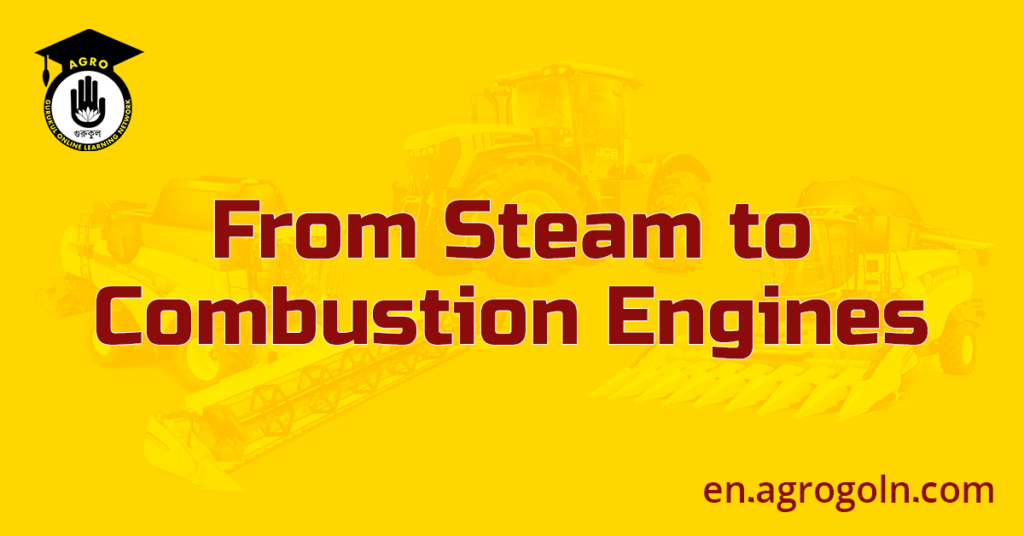The advent of the Industrial Revolution marked a significant shift in agricultural practices, particularly in the transition from animal-powered to mechanically driven machinery. Among the most influential developments were the inventions of the steam engine and the internal combustion engine. This article explores the transition from steam to combustion engines and its impact on the field of agricultural machinery.
From Steam to Combustion Engines
The Era of Steam Power
The steam engine, one of the greatest inventions of the Industrial Revolution, revolutionized agriculture by providing a reliable source of mechanical power. Invented by James Watt in the 18th century, the steam engine powered a multitude of machines, including locomotives, ships, factories, and, of course, agricultural machinery.
Steam-powered agricultural machines began making their appearance in the mid-19th century. The most popular of these were the traction engines and portable steam engines, which farmers used for various tasks, including plowing, threshing, and pumping water.
Traction engines were essentially self-propelled steam engines with large wheels that allowed them to move over rough farmland. Portable steam engines, on the other hand, were stationary machines that were transported to the job site and then used to power other machinery through a system of belts and pulleys.
Despite being bulky, heavy, and requiring a significant amount of coal and water, these steam-powered machines were a game-changer. They enabled farmers to complete tasks more efficiently than horse or human power allowed, increasing the productivity of farms and paving the way for larger-scale farming operations.
Transition to Combustion Engines
The late 19th and early 20th centuries saw a significant transition in agricultural machinery with the invention of the internal combustion engine. Unlike the steam engine, which relied on an external source of heat, the internal combustion engine generated power by burning fuel (like gasoline or diesel) inside the engine itself.
This transition was spurred by several factors. First, the invention of the internal combustion engine provided a more compact, efficient, and powerful source of energy. Second, improvements in steel manufacturing and mechanical design allowed for the creation of lighter and more robust machinery. Lastly, the growing availability and declining cost of petroleum fuels made combustion engines more economically viable.
The Otto and Langen engine, created in 1867, is often considered the first successful gas-powered engine. However, it wasn’t until the late 19th century that combustion engines began to find their way into agricultural machinery, replacing the steam engines previously used.
The Rise of Combustion Engines
The adoption of combustion engines led to significant advancements in agricultural machinery. The newfound portability and power enabled the development of smaller, more specialized machines that could perform a variety of tasks more efficiently.
Tractors, powered by internal combustion engines, were one of the most transformative innovations. Early models, such as the Froelich tractor in 1892 and the Hart-Parr Company tractors in the early 20th century, laid the foundation for modern tractor design.
Tractors powered by combustion engines offered several advantages over their steam-powered counterparts. They were lighter, making them less likely to get stuck in the field; more efficient, allowing them to work longer hours; and more versatile, with the ability to power a wide range of implements. These advantages led to widespread adoption of tractors on farms across the United States and the world.
Impact on Agriculture
The shift from steam to combustion engines had a profound impact on agriculture. The increased power and efficiency of combustion engines allowed for the development of larger, more productive farms. The tractor, in particular, transformed farming from a labor-intensive activity into a mechanized process, significantly increasing productivity.
Furthermore, the flexibility of combustion engines allowed for the diversification of farm machinery. New machines were developed to plant, harvest, and process a variety of crops, each designed to increase efficiency and reduce labor requirements.
However, this shift also brought challenges. The initial cost of combustion-engine machinery was high, putting them out of reach for many smaller farms. The increased mechanization of agriculture also led to a decrease in the need for farm labor, contributing to the migration of people from rural to urban areas during the 20th century.
The transition from steam to combustion engines marked a significant milestone in the history of agricultural machinery. The profound influence of this shift can still be seen today, with internal combustion engines remaining a key power source for modern farm machinery.
However, as we face the challenges of the 21st century, including climate change and resource scarcity, the world of agricultural machinery is set to witness another shift, this time towards more sustainable forms of energy. Just as the shift from steam to combustion engines revolutionized agriculture in the past, the ongoing transition to electric and autonomous farm machinery promises to shape the future of farming.
See more:
#Agro #Agriculture #AgroGurukul #AgricultureGurukul #GurukulOnlineLearningNetwork

